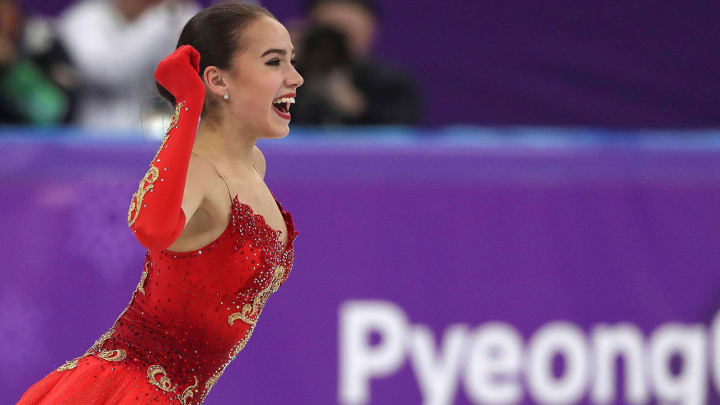Alina Zagitova Edges Evgenia Medvedeva to Win Gold as Russian Women Dominate Figure Skating

GANGNEUNG, South Korea—With talent and gamesmanship, the Russian women proved they deserved to be at the top of the Olympic figure skating podium.
There was no doubt as to which country would claim the newest Olympic figure skating queen; the only tension surrounded which skater she would be. Entering the free skate on Thursday night, Alina Zagitova of Olympic Athletes of Russia (OAR) led the field with a record-setting score after the short program, followed by her training partner and OAR teammate Evgenia Medvedeva.
By the end of the event, Zagitova retained her lead with a total of 239.57 points, followed by Medvedeva for silver and Canada’s Kaetlyn Osmond for bronze.
And for the U.S. ladies, it was the third Olympics in a row in which they failed to reach the figure skating podium. (Sasha Cohen earned the last Olympic medal, a silver, in 2006).
Zagitova emerged on the senior competitive figure skating stage this season, as Medvedeva recovered after injuring her foot in November. The world junior champion in 2017, 15-year-old Zagitova stormed the senior ranks with her consistent and seemingly unstoppable jumping ability, which continued right into PyeongChang. The reason for her mind-boggling scores? She saves all her high-value tricks like jumps for the second half of her routine, where they earn bonus points.
The strategy has paid off handsomely for the ballerina-like Zagitova, who says she is named after a Russian gymnast. She’s the current Russian national, European and now Olympic figure skating champion.
In her Don Quixote free skate, Zagitova made a rare error missing the second jump in a two-jump combination, but easily tacked it on to the end of another jump a few seconds later — not an easy thing to do when the jumps come rapid fire one after the other.
Even before the Olympic figure skating competition began, Zagitova seemed to already be looking far beyond the next few hours. While most skaters are struggling to contain nerves and keep focused, to warm up for the main event Zagitova whirled off a string of five triple jumps in a row, her way of laying claim not just to the current Olympics, but most assuredly the next Games as well. To put it in perspective, no men’s or ladies skater tries a triple-triple-triple combination; most three jump series include at least one, if not two, double jumps.
Medvedeva, 18, who dominated international competitions since the 2014 Olympics, trains with the same coach, Eteri Tutberidze, as Zagitova does in Moscow, and has been overshadowed a bit by Zagitova’s rising star over the past few months. Medvedeva does not back-load her programs in the same way as her training partner does; a more lyrical skater, Medvedeva opted for the less challenging triple-triple jump combination in her Anna Karenina free skate, and moved her highest value two-jump combination to the very top of her program where it couldn’t earn the additional points.
.@JannyMedvedeva was stunning in the free skate, a performance that earned her silver. #WinterOlympics https://t.co/fmMl0BMYXF pic.twitter.com/mZFRNI25mO
— NBC Olympics & Paralympics (@NBCOlympics) February 23, 2018
The U.S. ladies stayed where they after the short, ending the Olympics in ninth, tenth and 11th places with better free skates that still were still strewn with mistakes.
Mirai Nagasu planned a perhaps an overly ambitious nine triple jumps in her four minute program to “Miss Saigon,” including the triple axel. After popping the axel, for which she received no credit since she didn’t complete any rotations, she popped a triple lutz later in the program as well, which cost her valuable points and landed her in 10th place, behind teammate Bradie Tennell.
Tennell made up for her fall in the short program with her Cinderella routine, but she too showed signs of nerves as she missed a jump combination and had to make up for it later.
Teammate Karen Chen had a fall and stepped out of a jumping sequence and fell to 11th place.
Fifty-Eight Years After Making History, Kyung Soon Yim Discusses His Unlikely Olympic Past
Claiming the top spots on the podium, as the U.S. has done in the past with Olympic medalists like Kristi Yamaguchi, Nancy Kerrigan, Michelle Kwan, Tara Lipinski, Sasha Cohen, and Sarah Hughes, may take some rethinking about how to push senior skaters to keep innovating while encouraging young talent to develop. The two feed into each other; if younger skaters see those at the elite levels trying riskier technical and skating skills such as the more difficult triple-triple jump combinations, for example, or even triple axel jumps like Nagasu is doing, then they too will train more high level material and end up raising the level of skating. But if top skaters remain ensconced at the senior level with stagnant skills, then it’s less likely the pipeline of skaters behind them will be motivated to master riskier moves.
It’s something U.S. men’s national champion Nathan Chen noticed as an up and coming skater; at international competitions, he saw his rivals from Japan and Russia trying quadruple jumps, even though no one at home was doing them, and decided he needed to learn them too in order to stand on the international stage.
There’s nothing like competition to push athletes— it certainly worked for Medvedeva and Zagitova, who duel daily when they practice. Competing on Olympic ice was just another training day.
